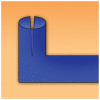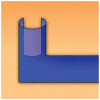Punctal stenosis: definition, diagnosis, and treatment
- PMID: 22848141
- PMCID: PMC3402122
- DOI: 10.2147/OPTH.S31904
Punctal stenosis: definition, diagnosis, and treatment
Abstract
Acquired punctal stenosis is a condition in which the external opening of the lacrimal canaliculus is narrowed or occluded. This condition is a rare cause of symptomatic epiphora, but its incidence may be higher in patients with chronic blepharitis, in those treated with various topical medications, including antihypertensive agents, and especially in patients treated with taxanes for cancer. The purpose of this review is to cover the medical literature, focusing in particular on definition, incidence, risk factors, etiology and treatment options.
Keywords: acquired punctal stenosis; definition; epiphora; etiology; treatment.
Figures




References
-
- Kashkouli MB, Beigi B, Murthy R, Astbury N. Acquired external punctal stenosis: etiology and associated findings. Am J Ophthalmol. 2003;136(6):1079–1084. - PubMed
-
- Kashkouli MB, Beigi B, Astbury N. Acquired external punctal stenosis: surgical management and long-term follow-up. Orbit. 2005;24(2):73–78. - PubMed
-
- Kakizaki H, Takahashi Y, Iwaki M, et al. Punctal and canalicular anatomy: implications for canalicular occlusion in severe dry eye. Am J Ophthalmol. 2011;153(2):229–237. - PubMed
-
- Olver J, Part A. Colour Atlas of Lacrimal Surgery. London, UK: Butterworth-Heinemann; 2001.
-
- Ball JM. Modern Ophthalmology: A Practical Treatise on the Anatomy Physiology, and Diseases of the Eye. 5th ed. Philadelphia, PA: FA Davis; 1926.
LinkOut - more resources
Full Text Sources
Other Literature Sources
Medical

